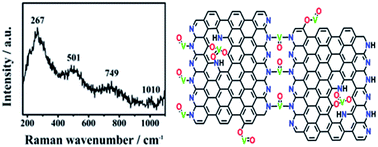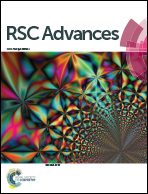Integrated electrospun carbon nanofibers with vanadium and single-walled carbon nanotubes through covalent bonds for high-performance supercapacitors†
Abstract
We report a ternary composite vanadium/single-walled carbon nanotubes (SWCNTs)/carbon nanofibers (VSCNFs) material using hybrid-electrospinning and carbonizing of polyacrylonitrile, polyvinylpyrrolidone, SWCNTs and vanadyl acetylacetonate. The morphology and structure of the ternary composites are characterized. Its electrochemical properties are measured in a 6 mol L−1 aqueous KOH electrolyte. VSCNFs possesses a hierarchical structure with micropores and mesopores and a specific surface area of 821 m2 g−1, and it also exhibits a reversible specific capacitance of 479 F g−1 at 1 A g−1 and 367.4 F g−1 at 10 A g−1, and retains 94% of its initial capacitance after 5000 cycles (8 A g−1). The results show that simultaneously adding vanadium and SWCNTs can greatly enhance the conductivity, capacitive performance and stability by forming a closer connection with nanofibers through V–N–C, V–O–C and V![[double bond, length as m-dash]](https://www.rsc.org/images/entities/char_e001.gif) O bonds. SWNCTs are not only mechanically mixed in CNFs to enhance the extent of graphitization, but also involved in the transmutation process of CNFs graphitization with the participation of vanadium.
O bonds. SWNCTs are not only mechanically mixed in CNFs to enhance the extent of graphitization, but also involved in the transmutation process of CNFs graphitization with the participation of vanadium.


 Please wait while we load your content...
Please wait while we load your content...